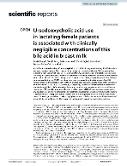Ursodeoxycholic acid use in lactating female patients is associated with clinically negligible concentrations of this bile acid in breast milk

Author
Kaslová, Barbora
Publication date
2022Published in
Scientific ReportsVolume / Issue
12 (1)ISBN / ISSN
ISSN: 2045-2322Metadata
Show full item recordThis publication has a published version with DOI 10.1038/s41598-022-24253-y
Abstract
In the literature on the safety of ursodeoxycholic acid (UDCA) during breastfeeding, insufficient data has been reported to date. Thus, the aim of our study was to analyze bile acid (BA) concentrations in breast milk in a cohort of patients, treated with UDCA, and with various cholestatic liver diseases. The study was carried out on a cohort of 20 patients with various cholestatic diseases. All the patients were treated with UDCA (500-1500 mg daily). Concentrations of BA, sampled on day 3 after delivery were analyzed using the GS-MS technique, and then compared to untreated women. Total BA concentrations in the breast milk of the UDCA-treated patients were equal to those of the untreated women controls (3.2 +/- 1 vs. 3.2 +/- 0.2 mu mol/L, respectively). The UDCA concentrations in breast milk remained negligible in UDCA-treated patients (0.69 mu mol/L), and in any event did not contribute to the newborn BA pool. No apparent side-effects of the maternal UDCA treatment were observed in any newborn infant, and no deterioration in postnatal development was observed during the routine 1-year follow-ups. Therapeutic administration of UDCA during lactation is safe for breastfed babies since UDCA only gets into breast milk in negligible amounts. UDCA treatment should be allowed and included into the guidelines for the therapy of cholestatic diseases in breastfeeding mothers.
Keywords
ursodeoxycholic acid, lactation, breast milk
Permanent link
https://hdl.handle.net/20.500.14178/1698License
Full text of this result is licensed under: Creative Commons Uveďte původ 4.0 International







